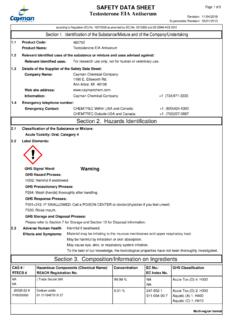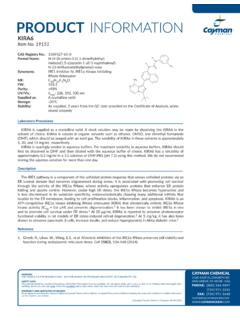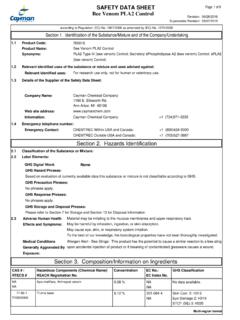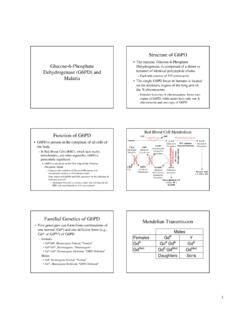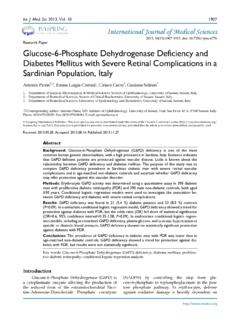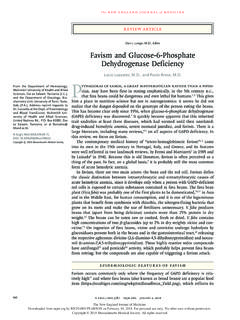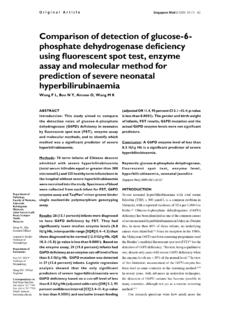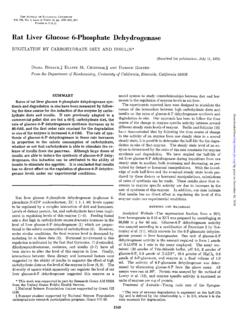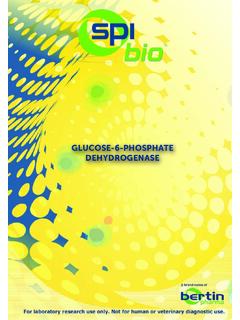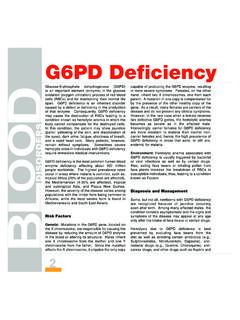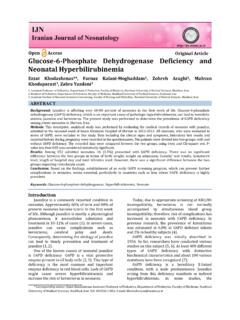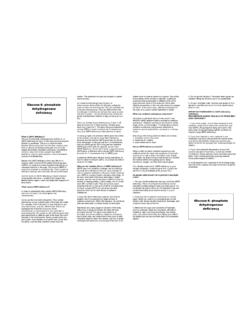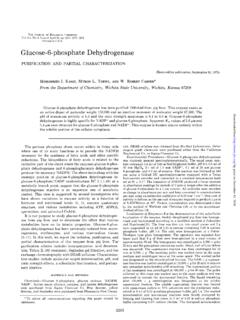Transcription of Glucose-6-Phosphate Dehydrogenase Activity Assay Kit
1 Service Support E. Ellsworth Rd Ann Arbor, MI USAG lucose-6- phosphate Dehydrogenase Activity Assay KitItem No. 7003003 GENERAL INFORMATIONTABLE OF CONTENTS GENERAL INFORMATION 3 Materials Supplied4 Safety Data4 Precautions4 If You Have Problems4 Storage and Stability4 Materials Needed but Not Supplied INTRODUCTION 5 Background6 About This Assay PRE- Assay PREPARATION 7 Reagent Preparation9 Sample Preparation Assay PROTOCOL 11 Plate Set Up13 Standard Preparation14 Performing the Assay ANALYSIS 16 Calculations17 Performance Characteristics RESOURCES 19 Interferences20 Troubleshooting21 References22 Plate Template23 Notes23 Warranty and Limitation of RemedyGENERAL INFORMATIONM aterials SuppliedItem NumberItemQuantity/Size700273G6 PDH Assay Buffer (10X)
2 1 vial/5 ml700274G6 PDH Substrate2 vials700275G6 PDH Cofactor2 vials700276G6 PDH Enzyme Mixture2 vials700277G6 PDH Fluorometric Detector2 vials700278G6 PDH Positive Control2 vials/50 l700279 NADPH Standard2 vials40001796-Well Solid Plate (black)1 plate40001296-Well Cover Sheet1 coverIf any of the items listed above are damaged or missing, please contact our Customer Service department at (800) 364-9897 or (734) 971-3335. We cannot accept any returns without prior authorization.!WARNING: THIS PRODUCT IS FOR RESEARCH ONLY - NOT FORHUMAN OR VETERINARY DIAGNOSTIC OR THERAPEUTIC INFORMATIONS afety DataThis material should be considered hazardous until further information becomes available. Do not ingest, inhale, get in eyes, on skin, or on clothing. Wash thoroughly after handling.
3 Before use, the user must review the complete Safety Data Sheet, which has been sent via email to your read these instructions carefully before beginning this You Have ProblemsTechnical Service Contact InformationPhone: 888-526-5351 (USA and Canada only) or 734-975-3888 Fax: 734-971-3641 Email: M-F 8:00 AM to 5:30 PM ESTIn order for our staff to assist you quickly and efficiently, please be ready to supply the lot number of the kit (found on the outside of the box).Storage and StabilityThis kit will perform as specified if stored at -20 C and used before the expiration date indicated on the outside of the Needed But Not Supplied1. A fluorometer with the capacity to measure fluorescence using an excitation wavelength of 530-540 nm and an emission wavelength of 585-595 nm2. Adjustable pipettes and a repeating pipettor3.
4 A source of pure water; glass distilled water or HPLC-grade water is acceptableINTRODUCTIONB ackgroundGlucose-6- phosphate Dehydrogenase (G6 PDH) is a cytosolic enzyme that catalyzes the first step in the pentose phosphate This pathway includes converting glucose to ribose-5- phosphate , a precursor to RNA, DNA, ATP, CoA, NAD, and FAD. The pathway also generates NADPH. Glutathione reductase uses NADPH to maintain the level of glutathione within the cell, thus protecting the cell from oxidative NADPH is also involved in fatty acid oxidation, lipid biosynthesis, and is the substrate for NADPH oxidase in activated macrophages and polymorphonuclear leukocytes to produce oxygen radicals which destroy pathogens. Most cells have alternate ways of generating intracellular NADPH such as the de novo pathway from amino acids.
5 Since red blood cells do not contain mitochondria, the pentose phosphate pathway is their only source of NADPH; therefore, defense against oxidative damage is dependent on G6 PDH. G6 PDH deficiency becomes especially lethal in red blood cells, where any oxidative stress will result in hemolytic ,4 G6 PDH deficiency, the most common enzyme deficiency worldwide, causes a spectrum of diseases including neonatal hyperbilirubinemia, acute hemolysis, and chronic It is estimated that about 400 million people are affected by this deficiency. Fortunately, most people will remain clinically asymptomatic throughout their lives. The deficiency is an X-linked hereditary genetic defect caused by mutations in the G6PD gene, showing a typical X-linked distribution pattern with higher incidence in males than in ,4 G6 PDH deficiency is known to provide protection against malaria, particularly the deadliest form of malaria caused by Plasmodium Areas endemic to malaria usually have more individuals with the deficiency, possibly because of an evolutionary PREPARATION6 INTRODUCTIONG6 PDH Activity has been shown to be upregulated in rat and mouse models of obesity, hyperglycemia, and G6 PDH is an important mediator of insulin resistance and is strongly activated post-translationally in (pre)
6 Neoplastic lesions to produce ,8 The tumor suppressor p53, the most frequently mutated gene in human tumors, inhibits G6 PDH by binding to the enzyme and preventing the formation of the active This AssayCayman s Glucose-6-Phosphate Dehydrogenase Assay provides a fluorescence-based method for detecting G6 PDH Activity in a variety of samples including erythrocyte lysates, tissue homogenates, and cell culture samples. In the Assay , G6 PDH catalyzes the oxidation of Glucose-6-Phosphate to 6-phospho-D-gluconate, along with the concomitant reduction of NADP+ to NADPH. NADPH reacts with the fluorometric detector to yield a highly fluorescent product which can be analyzed with an excitation wavelength of 530-540 nm and an emission wavelength of 585-595 PREPARATIONR eagent Preparation1.
7 G6 PDH Assay Buffer (10X) - (Item No. 700273)The vial contains 5 ml of 500 mM Tris-HCl, pH , containing 100 mM MgCl2. Dilute the contents of the vial with 45 ml of HPLC-grade water. This final Assay Buffer (50 mM Tris-HCl, pH , containing 10 mM MgCl2) is used in the Assay . The diluted Assay Buffer is stable for three months at 4 G6 PDH Substrate - (Item No. 700274)Each vial contains a lyophilized powder of Glucose-6-Phosphate . Reconstitute the contents of the vial with 600 l of diluted Assay Buffer. This is sufficient Substrate to Assay 60 wells. Prepare the additional vial as needed. The reconstituted Substrate is stable for one week at -20 G6 PDH Cofactor - (Item No. 700275)Each vial contains a lyophilized powder of NADP+. Reconstitute the contents of the vial with 600 l of diluted Assay Buffer.
8 This is sufficient reagent to Assay 60 wells. Prepare the additional vial as needed. The reconstituted Cofactor is stable for four hours at room G6 PDH Enzyme Mixture - (Item No. 700276)Each vial contains a lyophilized powder of enzymes. Reconstitute the contents of the vial with 600 l of diluted Assay Buffer and put the vial on ice. This is enough Enzyme Mixture to Assay 60 wells. Prepare the additional vial as needed. The reconstituted enzymes are stable for four hours at 4 PREPARATION9 PRE- Assay PREPARATIONS ample PreparationErythrocyte LysateTypically, normal human erythrocyte G6 PDH Activity is in the range of 5-20 mol/min/g Collect blood using an anticoagulant such as heparin or Centrifuge at 1,000 x g for 10 minutes at 4 C. Remove the top plasma and buffy coat Dilute the erythrocytes 1:1 with phosphate buffered saline (pH ) and place on ice ( , 1 ml erythrocytes and 1 ml of buffer).
9 NOTE: This is a 1:2 dilution of the erythrocytes that will have to be included in the On ice, sonicate the erythrocytes with a few short bursts to break open the If not assaying the same day, freeze at -80 C. The sample will be stable for one month while stored at -80 Further dilute the lysate 1:10-1:20 with Assay Buffer before : Erythrocyte G6 PDH Activity can be standardized to hemoglobin content using Cayman s Hemoglobin Colorimetric Assay Kit (Item No. 700540).5. G6 PDH Fluorometric Detector - (Item No. 700277)Each vial contains a lyophilized powder of fluorometric detector. Reconstitute the contents of the vial with 600 l of diluted Assay Buffer. This is sufficient reagent to Assay 60 wells. Prepare the additional vial as needed. The reconstituted mixture is stable for one week at -20 G6 PDH Positive Control - (Item No.)
10 700278)Each vial contains 50 l of Glucose-6-Phosphate Dehydrogenase . Add 450 l of diluted Assay Buffer to the vial and put the vial on ice. Further dilute 10 l of enzyme with ml of diluted Assay Buffer and store on ice. This enzyme will be assayed as the Positive Control. The diluted enzyme is stable for four hours at 4 NADPH Standard - (Item No. 700279)Each vial contains a lyophilized powder of NADPH. Reconstitute the contents of the vial with 2 ml of diluted Assay Buffer to yield a 1 mM solution of NADPH. The reagent is ready to prepare the standard curve. The reconstituted Standard is stable for four hours at 4 PROTOCOL10 PRE- Assay PREPARATIONCell Lysate1. Collect cells (~3 x 106 cells) by centrifugation ( , 1,000-2,000 x g for 10 minutes at 4 C).


